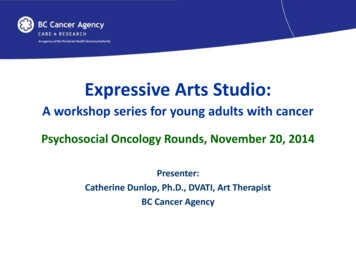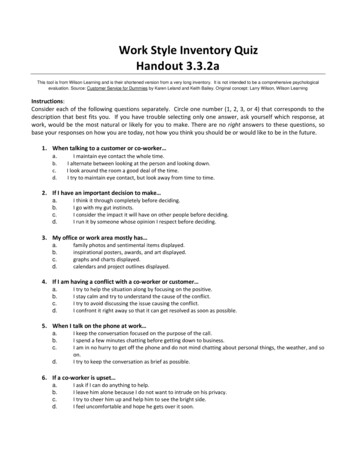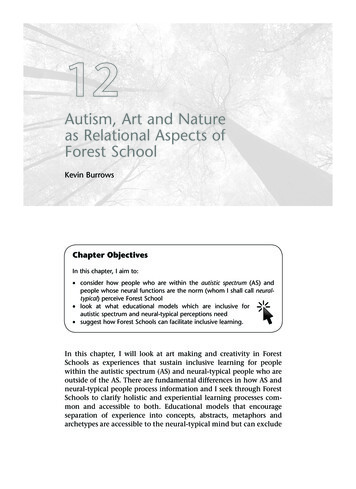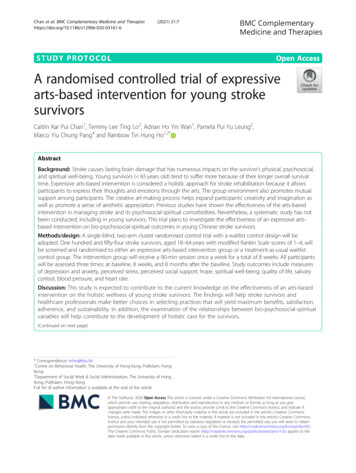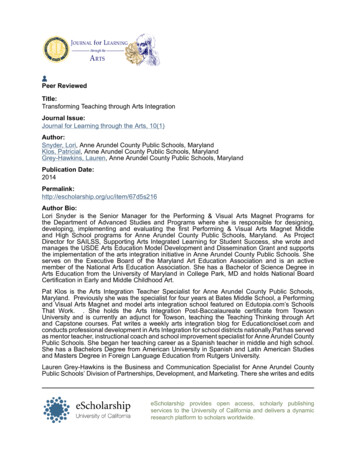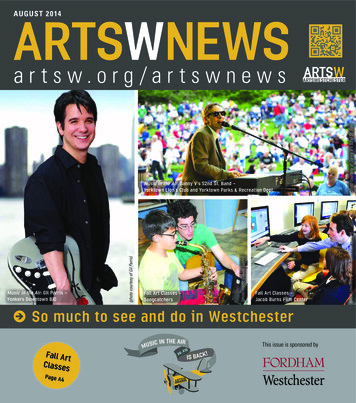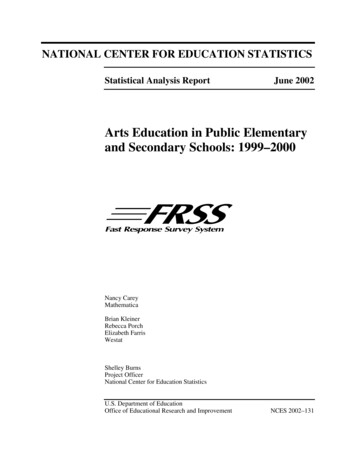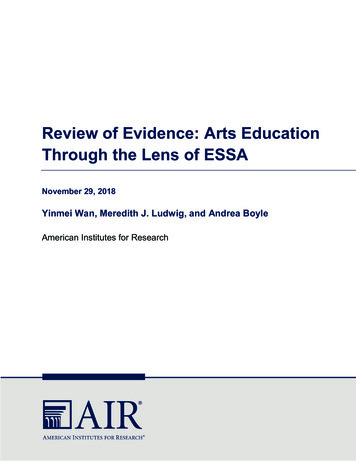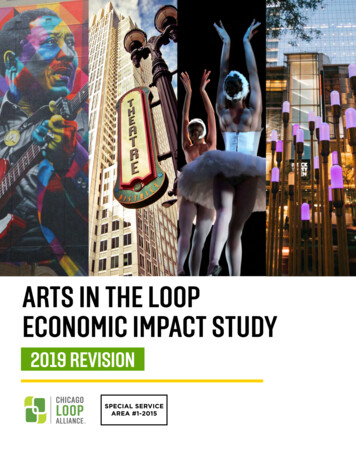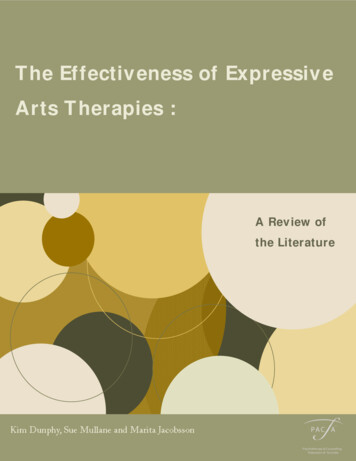
Transcription
The Effectiveness of ExpressiveArts Therapies :A Review ofthe Literature
PACFA, November 2013This publication is copyright. No part may be reproduced by any process except inaccordance with the provisions of the Copyright Act 1968.Suggested citation:Dunphy, K., Mullane, S., and Jacobsson, M. (2013), The effectiveness of expressive artstherapies: A review of the literature. Melbourne: PACFA.Acknowledgments:The review was generously funded by an anonymous philanthropic body.Correspondence concerning this article should be addressed to:Kim DunphyEmail: kimfdunphy@gmail.com
ForewordThis document is a literature review of research into the effectiveness of expressive artstherapies, intended as a resource for counsellors and psychotherapists. It demonstrates theeffectiveness of expressive arts therapies for a range of physical and psychological conditions.The PACFA Research Committee recognises that it is important to counsellors andpsychotherapists that they have access to recent research evidence that demonstrates theeffectiveness of different therapeutic approaches, to assist them in their practice. This review isone of a series of reviews that has been commissioned by the PACFA Research Committee tosupport its Member Associations in their work. It was written on behalf of the PACFA ResearchCommittee. However, this does not imply that PACFA or its Member Associations endorses anyof the particular treatment approaches described.The Committee endorses the American Psychological Association’s definition of evidence-basedpractice as ‘the integration of the best available research evidence with clinical expertise in thecontext of patient characteristics, culture and preferences’- although we refer to a client orconsumer rather than ‘patient' – and the Common Factors research that has shown thecentrality of the therapeutic relationship to therapeutic effectiveness, and the relatively minimalrelevance of specific techniques.The Committee recognises that there is significant research evidence to indicate theeffectiveness of counselling and psychotherapy and that different methods and approachesshow broadly equivalent effectiveness. The strength of evidence for effectiveness of any specificcounselling and psychotherapy intervention or approach is a function of the number,independence and quality of available effectiveness studies, and the quality of these studies is afunction of study design, measurements used and the ecological validity (i.e. its approximationto real life conditions) of the research.The Committee acknowledges that an absence of evidence for a particular counselling orpsychotherapy intervention does not mean that it is ineffective or inappropriate. Rather, theevidence showing equivalence of effect for different counselling and psychotherapyinterventions justifies a starting point assumption of effectiveness.It should be noted that this review is necessarily limited in its scope and covers four of the maintypes of expressive arts therapies: music, visual art, dance-movement, and drama, which wereinvestigated for evidence of outcomes. It examines the types of mental health issues thatexpressive art therapies are effective in treating.The Committee is committed to supporting PACFA Member Associations and Registrants todevelop research protocols that will help the profession to build the evidence-base to supportthe known effectiveness of counselling and psychotherapy. We hope that you will find thisdocument, and others in this series, useful. We would welcome your feedback.Dr Elizabeth DayChair of the PACFA Research Committee, 2013
ContentsAbstract . 1Literature Review . 2Introduction . 2Method . 2Definitions . 2Key search terms . 3Scope. 4Inclusion and exclusion criteria for literature. 4Literature synthesis . 4Findings . 4Music therapy literature synthesis . 5Art therapy literature synthesis . 6Dance-movement therapy literature synthesis . 8Drama therapy literature synthesis . 9Discussion . 10Conclusion . 12References . 14Appendix 1 . 19Appendix 2 . 22Appendix 3 . 24Appendix 4 . 27
AbstractThis article presents a systematic review of literature about the effectiveness of expressivearts therapies. Research about five therapy modalities: music; visual art; dance-movement;drama and writing was investigated for evidence of outcomes. This review documents themodest literature within the inclusion criteria of systematic reviews and randomisedcontrolled trials from Australian literature (2002-2012) and international literature (20072012). Only two Australian authored articles, both from the field of music therapy, fittedselection criteria. Recurring issues with methodology included predominantly smallsamples (n from 10-1891, but largely clustered between 15 and 40) and lack of inclusion offollow up or longitudinal data. Much of the research is inconclusive, but there are sufficientfindings of quality to indicate benefits of expressive arts therapies. Effectiveness isindicated for physical and psychological conditions including asthma, dementia, coping withcancer, terminal illness, depression, schizophrenia, stress, anxiety, emotional eating andAutism Spectrum Disorder.Keywords: expressive arts therapy, creative arts therapy, music therapy, art therapy,dance-movement therapy, drama therapy, psychodrama, writing therapy, systematicreview, effectiveness.Page 1
Literature ReviewIntroductionThis article was commissioned by the Psychotherapy and Counselling Federation ofAustralia (PACFA) as part of a series of reviews investigating the effectiveness ofpsychotherapies in Australia. Definitions of key terms regarding expressive and creativearts therapies are provided first. Next, the article outlines search terms, data retrievalmethods and literature sources. The research process, including strategies for determiningthe quality of evidence, is discussed. Four short summaries of the literature are provided:one each for music therapy; art therapy; dance-movement therapy and drama therapy.The exclusion of writing therapy from the analysis is explained. The article concludes with adiscussion that brings together findings about the four modalities regarding theeffectiveness for arts therapies overall. Issues arising with respect to methodology andoutcomes are discussed. Recommendations for future arts therapy research are made; anextensive bibliography is provided; and four tables attached as Appendices provideinformation about all the studies that fitted the selection criteria.MethodDefinitionsThe literature indicates a variety of terms used for similar activities, so definitions of termsrelevant to arts therapies are explored here. The terms “expressive arts therapy” and“creative arts therapy” were found to be used interchangeably, referring to the overallpractice of the arts applied as therapy. “Expressive arts therapy” is more common inEuropean practice, while “creative arts therapy” is more frequently used in Australia. Bothterms can also refer to a multi-modal approach wherein a therapist employs a range of artforms as an integral aspect of their practice.In contrast, the term “art therapy” (singular) generally refers only to visual art therapy,while “arts therapy” may refer to a range of different visual art forms. However, thisdefinition is also problematic, as this term used in the plural also refers to the overallpractice of arts as therapy, which might include visual, but also other, art forms.PACFA provides the following description of expressive arts therapies:All art forms offer avenues for inquiry into personal life meanings.Understandings can be gained through using the art form to represent andconstruct your own story, or by using forms already created, such as dramas,poems, paintings, novels or musical compositions. The purpose is always tocreate re-experiencing of selected aspects of your life so as to understand andPage 2
consider them as you make sense of them. Some approaches use single art forms,whilst others may invite you to use a number of ways of expressing what isimportant to you, including talking about your experiencing as you inquire into it(PACFA 2012).While this describes a process that may be “therapeutic”, it does not specifically mention“therapy”. Therefore, the definition is lacking, as it does not fit one significant criteria oftherapy, that both client and practitioner must both understand the process that they areengaged in as “therapy” in order for it to be so. This concept of therapy is better explicatedin PACFA’s definition of counselling and psychotherapy: “Professional counsellors andpsychotherapists work within a clearly contracted (italics review authors), principledrelationship that enables individuals to obtain assistance in exploring and resolving issuesof an interpersonal, intrapsychic, or personal nature” (PACFA, 2013).For the purposes of this review, the definition provided by the Australian and New ZealandArts Therapy Association (ANZATA) of “creative arts therapies” will be used to stand forboth “creative” and “expressive arts therapies”.Arts therapy or arts psychotherapy is a form of psychotherapy that uses creativemodalities, including visual art-making, drama, and dance/movement to improveand inform physical, mental and emotional well-being. Arts therapy works byaccessing imagination and creativity, which can generate new models of living,and contribute towards the development of a more integrated sense of self, withincreased self- awareness and acceptance (ANZATA, 2012).However, this definition, while more specific about the therapeutic process and morecomprehensive, does not mention music therapy. An additional challenge in finding adefinition that covers all the modalities is that music therapists do not consider their workas psychotherapeutic (D. Grocke, personal communication, October 26, 2012).“Dance movement therapy” is the term currently used by the Australian professionalassociation, but this modality also appears in the literature as “dance-movementpsychotherapy” (UK) and “dance therapy” or “dance/movement therapy”, (primarily in theUS but also other countries). While the terms “drama therapy” and “psychodrama” aresometimes used interchangeably, in this review “psychodrama” is categorised as atherapeutic process within the modality of “drama therapy”.Key search termsKey search terms were: expressive arts therapies; expressive art therapies; expressive arts therapy;creative arts therapy; creative arts therapies;music therapy, music and guided imagery;art therapy, art psychotherapy, arts therapy, arts therapiesPage 3
dance therapy, dance-movement therapy, dance psychotherapy, dance-movementpsychotherapy;drama therapy, drama psychotherapy, psychodrama;expressive writing, including poetry therapy, and other forms of creative writing astherapy.ScopeA comprehensive computer-assisted literature search was undertaken of databases andelectronically accessible journal articles that documented outcomes of creative artstherapies. Databases searched were the Campbell Collaboration; Academic SearchComplete; AMED Alternative Medicine; EBSCOHost; Expanded Academic ASAP; PubMED;PsycArticles; and PsycINFO. Also searched was the Cochrane Database of SystematicReviews (CDSR), which, as part of the larger Cochrane Library, is a leading resource forsystematic reviews and meta-analyses of world-wide, independent, evidence-based healthand medical practice (www.cochrane.org). Hand-searches were also undertaken of specificpeer-reviewed journals including the American Dance Therapy Journal; Arts inPsychotherapy; Art Therapy Online; Australian and New Zealand Journal of Family Therapy;Australian Journal of Music Therapy; and the British Journal of Music Therapy. Websites ofrelevant professional associations were also searched for references.Inclusion and exclusion criteria for literatureThis review investigated literature on five creative arts therapeutic modalities: music; art;dance-movement; drama and writing. This focussed on English-language literaturepublished in Australia between 2002 and 2012 and internationally between 2007 and 2012.Only material available in electronic format was considered. The search prioritisedsystematic, or other, reviews of the literature and controlled trials, primarily those withfully randomised design. Studies that did not specifically identify a creative arts therapymodality were excluded, even if they involved arts participation that had a beneficial ortherapeutic outcome.Literature synthesisIn organising the synthesis of the studies, headings were selected to match those used byEvans, Turner and Trotter (2012), in their review of family and relationship therapycommissioned by PACFA. This was considered to assist comparability across PACFA’sreview series. These headings were: Author/date/location; Methodology/ study type;Substantive focus; Participants; Outcomes/ measures; Follow up; Conclusion regardingeffects of therapy interventions.FindingsThis section includes a synthesis of the literature for four creative arts modalities: music,Page 4
art, dance-movement and drama therapies. No studies about any form of writing therapyfitted the inclusion criteria, so no information about this form of therapy is provided.Nevertheless, the practice of poetry therapy is well established in North America andEurope and takes place in a range of medical, allied health and education settings (Heimes,2011). Nor were any multi-modal studies included. Despite professional interest inapproaches that apply more than one art form, for example, as propounded by the traininginstitution Melbourne Institute for Experiential and Creative Arts Therapies (MIECAT), noresources were found that discussed this practice, other than where more than one visualart form was involved.Music therapy literature synthesisMusic therapy is an allied health profession and creative arts modality practicedthroughout Australia and in more than 40 other countries (Australian Music TherapyAssociation, 2012). Professional associations were established in the UK in 1958, USA in1971 and Australia in 1975 (Grocke, 2005). In music therapy, music is used by aprofessional who is both a “proficient musician” and “qualified therapist” within atherapeutic relationship to address physical, emotional, cognitive and social needs ofindividual clients (Australian Music Therapy Association, 2012). Music therapy is used toaddress an increasing range of client issues, including brain trauma, dementia and palliativecare, and children with intellectual disabilities (Grocke, 2005). Its relative longevitycompared to other modalities may explain why music therapy is one of the mostresearched mediums of the creative arts therapies. Music therapy had the strongest bodyof quantitative literature of all the modalities investigated.Thirty-two studies on outcomes of music therapy were identified in this review, eight ofwhich matched the selection criteria. These were four international systematic reviews ofquantitative studies using randomised controlled trials, and four single controlled trialstudies. One of the systematic reviews had one Australian contributing author and two ofthe single controlled trial studies were wholly undertaken by Australian researchers. Thesystematic reviews focussed on studies with population groups including cancer patients(Bradt, Dileo, Grocke & Magill, 2011); people in end of life care (Bradt & Dileo, 2010); adultswith depression (Maratos, Gold, Wang & Crawford, 2008); and children with AutismSpectrum Disorder (Gold, Wigram & Elefant, 2006). In each case the findings suggestedthat whilst music therapy did no harm, there was insufficient data to confirm its positiveeffects for the population. These authors were consistent in their advocacy for musictherapy research to incorporate more high quality studies using larger samples, moreaccurate tools for outcome assessments, more rigorous designs and long term trials.The four single controlled studies provided information about the effectiveness of musictherapy with: children with Autism Spectrum Disorder (Gattino, dos Santos Riesgo, Longo,Loguerico Leite & Faccini, 2011); (Kim, Wigram & Gold, 2008); palliative care (HorneThompson & Grocke, 2008); and Alzheimer’s type dementia (Ledger & Baker, 2007).Page 5
Gattino et al (2011) researched the application of Relational Music Therapy (RMT) withchildren who have Autism Spectrum Disorder. RMT was developed as a form of musictherapy to help individuals develop their motor, communicative, social, cognitive andemotional capacities stimulated by interactions, between client and therapist in thetherapeutic setting. These interactions can include singing, composing and playing musicalgames in an unstructured format. However, the study results were inconclusive, whichthose authors attribute to small sample size (n 24), use of an inadequate instrument tomeasure the outcomes, and difficulties caused by the physical setting for the music therapyinterventions (p. 149-150). Kim et al (2008) undertook a RCT to examine the impact ofimprovisational music therapy on joint attention behaviours in pre-school children withautism. Results indicated that music therapy was more effective than play sessions infacilitating joint attention behaviours and non-verbal social communication skills inchildren.The only wholly Australian authored research that could be included in this review were thefollowing two studies. Horne-Thompson and Grocke (2008) examined the use of musictherapy in palliative care settings, seeking specifically to address a gap in the literature ofresearch governed by sufficient controls. They wished to determine if the use of musictherapy would help reduce anxiety and its debilitating effects for palliative care patients.Results indicated that music therapy reduced patient anxiety when anxiety was measuredby participant self-report, but not when lowered heart rate was the measure. Furtherinvestigation was recommended to justify financial investment of a music therapyapproach. Ledger and Baker (2007) focussed on the use of music therapy to reduce, infrequency and intensity, agitation in older clients with dementia. The authors reportedthat, as there were no significant differences between the experimental and control groupsover time, music therapy may only have immediate, rather than cumulative and long-termeffects, on agitated behaviours. Music therapy interventions did however, have a positiveinfluence on other client areas of functioning, including wandering, fidgeting, grabbing andverbally aggressive behaviour, suggesting that future research could investigate themodality’s support for quality of life with this client group.The studies included in this review indicate that the majority of high calibre quantitativeresearch into music therapy is conducted outside Australia. Although some researchindicates inconclusive results, these studies do confirm the positive impact music therapycan have on adults experiencing cancer, terminal illness, dementia and depression, and forchildren diagnosed with Autism Spectrum Disorder. These studies also confirm the needfor further research that utilises larger sample sizes and long-term trials, in particular, todetermine the efficacy of music therapy.Art therapy literature synthesisArt therapy, a modality that uses visual arts as the therapeutic intervention, emerged in the1940s in Europe as a form of psychotherapy (Hogan, 2001). This modality was establishedPage 6
in Australia between the 1950s and the 1990s by a group of local and international artists,psychiatrists, psychologists and educators. Several of these practitioners undertooktraining in the UK and USA before returning to Australia (Westwood & Linell, 2011). TheAustralian and New Zealand Arts Therapy Association (ANZATA), founded in 1987, and theAustralian Creative Arts Therapies Association (ACATA), founded in 1998, are peak bodiesfor art therapy in Australasia. Arts therapies are traditionally based on psychoanalytic orpsychodynamic principles, and most arts therapists utilise varied evidence basedtheoretical frameworks in their work. These traditions include depth analytic, humanistic,behavioural, systemic, and integrative approaches. Arts psychotherapy can be employed asboth a therapeutic and diagnostic tool (ANZATA, 2013).Twelve articles that examined the effectiveness of art therapy were identified, five of whichmet the inclusion criteria. One of these was a systematic review, and the others,randomised controlled trials conducted in Europe, the UK and the USA. No Australianstudies that met the inclusion criteria were identified.One study examining arts therapy for mental illness had inconclusive results. Ruddy andMilne’s (2009) systematic review of RCTs of art therapy as an adjunct treatment forschizophrenia and other mental illnesses found only two studies that met their inclusioncriteria. The small sample sizes of these studies (total n 137) precluded conclusivefindings. Another study investigating the effects and cost effectiveness of group arttherapy for people with established schizophrenia was conducted by Crawford et al. (2012).No improvements were identified in outcome measures testing global functioning, mentalhealth, or other health related outcomes, with low attendance identified as impacting onthis result.Three RCT studies indicate support for the effectiveness of art therapy for health issues:asthma; depression; and coping with breast cancer. Beebe, Gelfand and Bender (2010)measured the effectiveness of art therapy with 22 children suffering chronic asthma.Results were significant, showing that a program of art therapy lowered anxiety andimproved quality of life and self-concept, with benefits persisting six months aftertreatment. The study conducted by Thyme et al. (2007) comparing short-termpsychodynamic art therapy with psychodynamic verbal therapy for women with depressionfound that participants in both groups reported fewer depressive and stress-relatedsymptoms at the conclusion of the trial and again at follow up. Svensk et al. (2009)reported an overall increase in coping resources among women with breast cancer after anart therapy intervention. Therefore, of the five art therapy studies reviewed, three indicatesupport for the benefits of art therapy for health concerns: asthma; depression; and copingwith breast cancer. The inconclusive results and no improvements from the other twostudies may be largely attributable to methodological limitations.Recommendations for further and improved research were made by Slayton, D’Archer andKaplan after their review of 35 studies on the efficacy of art therapy (2011). These authorsPage 7
found a small body of quantifiable data indicating that art therapy is an effective treatmentfor people across a spectrum of ages, with a variety of symptoms and disorders. Gilroy(2006) recommends mixed qualitative and quantitative designs to explore aspects of thetherapeutic process, stating that “.interventions that involve relationships and socialinteraction need accompanying qualitative data that document therapeutic processes andinclude user views about their experience of what has been important and effective” (p.114).Dance-movement therapy literature synthesisDance-movement therapy (DMT) began as a formal psycho-therapeutic practice in theUnited States in the 1940s (Bartenieff, 1972). Professional associations were established inthe US in 1966, the UK in 1982 and in Australia in 1994. The American Dance TherapyAssociation (ADTA, 2012) defines dance-movement therapy as “the psychotherapeutic useof movement to further the emotional, cognitive, physical and social integration of theindividual based on the empirically supported premise that the body, mind and spirit areinterconnected” (ADTA, 2012). Dance-movement therapists in Australia work with clientsacross the lifespan to address a range of issues of psychological and physical originincluding depression, anxiety, trauma, relationship and adjustment issues, dementia,disability and behavioural problems (Dance-Movement Therapy Association of Australia,(DTAA), 2012).This review identified twenty-six studies on outcomes of dance-movement therapy, eight ofwhich matched the selection criteria. Five were reviews and three, controlled trials, two ofwhich had a fully randomised design. No articles written by Australians or published inAustralia could be included.One systematic review published in the Cochrane Review (Xia & Grant, 2009) is the first onDMT to be included in that database. While Xia and Grant’s (2009) article regarding theeffectiveness of dance therapy for schizophrenia indicates inconclusive results from a singlestudy, its inclusion in the Cochrane Review does pave the way for further research.Meekums, Karkou and Nelson’s (2012) review on the effects of DMT for depression is at theprotocol stage for Cochrane review, and findings are as yet unavailable. These authorsrecommended that a full Cochrane review be undertaken regarding DMT and depression,after a scoping review of nine studies indicated the value of deeper investigation. Bradt,Goodill and Dileo’s (2011) review on the potential of DMT for people who have cancer alsohad an inconclusive result. Psychological and physical outcomes of DMT could not beconfirmed because only two studies were found. One of those studies, did however,suggest that DMT may have a beneficial effect on the quality of life of women with breastcancer. Kiepe, Stöckigt and Keil (2012) documented beneficial results from eleven trials onthe effects of DMT for adults with a range of physical and mental illnesses.In the single studies documented, Brauninger (2012) reported that DMT appeared effectivein improving stress management and reducing psychological distress. Further, it appearedPage 8
that DMT seemed effective even after a short period of treatment (ten weeks) and thateffects lasted over time. Meekums, Vaverniece, Majore-Dusele and Rasnacs (2012) foundsimilar reductions in psychological distress in the DMT treatment group for obese womenwith emotional eating. This study also indicated other positive outcomes for thispopulation including decreased body image distress, increased self-esteem and reducedemotional eating. DMT was also indicated as an option for treating dementia, having smallpositive effects on cognition and self-care abilities, despite no effects being indicated formemory (Hokkanen et al., 2008).These reviews confirm that DMT can be an effective therapeutic intervention for peoplewith conditions including schizophrenia, cancer, depression, stress, emotional eating anddementia. They also indicate that most DMT studies to date have had small sample sizesand yielded inconclusive results. However, dance-movement therapy is practiced aroundthe world with a range of clients and conditions far broader than this list would indicate,pointing to significant opportunities for further high quality research.Drama therapy literature synthesisDrama therapy is relatively new as a psychotherapeutic profession and academic discipline.although it draws from ancient ritual practices (Jones, 1996). It developed in the 1970sfrom theoretical foundations including theatre, psychology, psychotherapy, anthropology,and play. A major influence is the concept of psychodrama developed by Jacob Moreno inthe 1920s and 30s as a method of group therapy based on encounter and enactment(Mor
Arts Therapy Association (ANZATA) of creative arts therapies will be used to stand for both creative and expressive arts therapies . Arts therapy or arts psychotherapy is a form of psychotherapy that uses creative modalities, including visual art-making, drama, and dance/movement to impr

